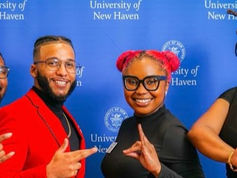“Not Professional Enough": My Experience with Racism in High School
- horseshoemag
- Apr 11
- 4 min read
Contributing Writer
Mirakel L. Spellman
Have you ever wondered what racism is like firsthand?
This is my experience.
I went to a high school that was predominantly white. It was stereotyped by other schools for having “rednecks and truckers.” As an African American who attended this school, I had to deal with people of color always asking me why I went there.
I never questioned where I was going or how others were going to see me based on my race. It never crossed my mind that I was going to deal with racism in high school because I never experienced it in middle school.
During my freshman year, my classmates made racial comments that I had to report to my school. One day I arrived at school with box braids, and two guys approached me during computer class and told me my braids were “ghetto.” What made my braids ghetto compared to the girls who were not African American? Or those who had French or Dutch braids?
My school addressed the issue, and when they spoke with me, they said that the parents were upset that their child said something like that and called it unacceptable.
There has always been discrimination toward African American hair that’s curly and kinky. During and after slavery, there were beauty standards that targeted Black women's hair. You had “good hair” if it was straight, smooth and silky. “Bad hair” was coiled, curly and kinky with a thicker texture. This created this bias that people with “good hair” were more attractive and socially accepted. However, if you had “bad hair,” it was ugly and unattractive.
Women of color were discouraged from embracing their natural hair. There has always been a microaggression toward hair, with comments of “Your hair looks better straightened.” Women of color were influenced to use relaxers and hair straighteners to fit the white beauty standards and to look “professional.” African Americans were discriminated against for looking “unprofessional” when they had afros, braids, dreads or twists.
There’s a negative bias toward children and teenagers of color in schools that restricts them from having braids, afros or dreads. One teenage boy in Texas was told he had to cut his dreadlocks to walk at his graduation, in order to meet the school district’s dress code. The dress code was “hair must be clean and well groomed.” What makes dreadlocks not clean?
I want to bring awareness to others that there has always been discrimination toward African American hair, from slavery to today’s society.
During my freshman year, we had assigned seats in math class, and I had to sit with a guy from a different town. There were times he would call me a monkey and talk about how bad Black people are. I had to write a statement to my school about how they would handle the issue. A counselor and a teacher pulled me into the office after I wrote the statement and said I shouldn’t have to deal with students making racial comments toward me. However, they excused his behavior because his mother had died of cancer. I was the victim of racism, but since his mother died, I just had to accept that it happened and move forward.
Racism is formed by various influences throughout life — from parental to peers. As individuals, our views are influenced by the people around us, often when we are younger. A child will absorb their parent's explicit and implicit biases. If they say racist jokes and negative comments about a race in their home, this child will hear these comments and see prejudiced behaviors as acceptable. This behavior will follow them through their lives. These actions will impact them as a person and affect others they harm. These children and teenagers will start making racist jokes and negative comments about other races in school.
Schools downplay racism, which is a significant issue that impacts a student’s understanding of racial dynamics.
When racism is not confronted, it becomes normalized. Students will grow up thinking that racist attitudes and behaviors are acceptable. This perpetuates a cycle of discrimination into adulthood. Schools’ lack of consequences minimizes the situation. A student of color should feel comfortable reporting racism and know the school will handle the problem correctly. However, schools will call it a “misunderstanding” or a simple “bullying incident” without addressing the racial aspect. When a racist student receives no consequences for making racist comments, this perpetuates harmful stereotypes into their adult life. When these comments are acceptable at home and schools don’t give any consequences for their racist behavior, it doesn’t help the problem we are having in America.
I want my story to bring awareness to women of color to speak up about the comments made toward them about their hair. We shouldn’t deal with discrimination toward our hair just because it doesn’t fit the white beauty standards.
I want to bring awareness to school administrations downplaying racism when a victim is coming to them about the issue. Schools need to address the racial disparities that occur in the system and take action against prejudiced behavior.
No one becomes racist from something that happened in their personal life. Everyone can’t be the victim in the story — it’s about taking accountability for the situation and addressing the concern.
Racism isn’t born. It’s learned.














Comments